Hazchem code means hazardous chemical code, it is also known as ‘Emergency action code’. It is a warning plate system used for vehicles that transport hazardous substances. Actually, it gives information’s about the actions to be taken in case of accidental fire or spillage or leakage, or any emergency.
The Hazchem code is a number, followed by one or two letters, e.g., 3WE, 2XE, etc and it is a pictorial representation consisting of a diamond. They are used in various countries such as the United Kingdom, India, Australia, New Zealand, etc. The Hazchem code defines.
- Method of controlling spillage by diluting or by containing.
- Personal protective equipment is required for firefighters.
- Reactive nature of the chemical.
- Need for evacuation.
Table of Contents
Purpose of Hazchem code:
The basic purpose of the Hazchem code is to provide a hazard information system that gives direct information or guidance to the emergency services on the action to take during the initial stages of a chemical incident or in case of fire or spillage or leakage without the user having a detailed knowledge of chemistry.
Hazchem codes may also be used on storage facilities of hazardous chemicals. It helps to take action quickly in case of an accident.
How to read the Hazchem code?
- The code consists of a number followed by one or two letters (e.g., 3WE, 4X, etc). The number indicates the type of extinguishing media (e.g., water, foam, dry agent, etc.) used in case of fire.
- The first letter (Placed in the second position) indicates the type of personal protective equipment required along with the information about the possibility of violent reaction of chemicals and whether the substance should be contained or diluted.
- The last letter is “E”. E means evacuating people from the neighborhood of the incident. Some organizations are recommended that at least the area within a radius of 300 meters shall be considered for evacuation where E appears in the Hazchem code.
Hazchem code chart:
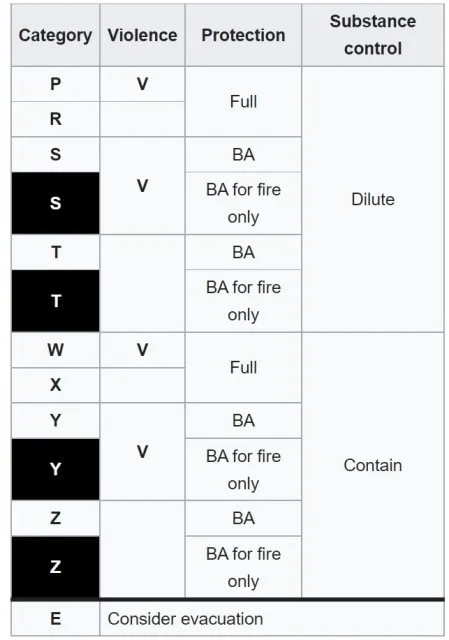
Notes:
- V – Can be violently or even explosively reactive.
- BA protection – Use breathing apparatus plus protective gloves.
- FULL protection – Use full-body protective clothing with breathing apparatus.
- DILUTE – Wash to drain with large quantities of water.
- CONTAIN – Prevent spillage from entering drains or watercourses.
The first digit in a Hazchem code is a number that indicates which type of fire extinguishers are required to extinguish the fire.
Numbers:
- Water jets
- Fog
- Foam
- Dry Agent
Alphabets:
Each Hazchem code contains at least one of the letters P, R, S, T, W, X, Y, and Z. The final letter of the Hazchem code is E, E means Evacuation.
P R S T – Material needs to be Diluted
W X Y Z – Material needs to be Contained
V – Can be violently or can be explosively reactive
E – Consider evacuation as first priority
Substance Control:
Dilute:
Dilute means, the spilled chemical can be washed and reduce the concentration of chemical
Contained:
It should be prevented to get into the drain pipes or water channels.
Black background white font letter:
The alphabet shown in black background with white font represents there is a danger of violent reaction or explosion. The details are given below.
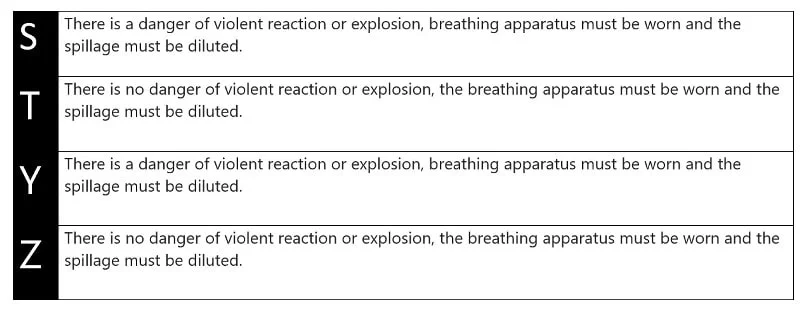
Hazchem signs:
- Explosive (Class1)
- Flammable (Classes 2, 3, 4)
- Oxidizing (Class 5)
- Toxic (Class6)
- Corrosive (Class 8)
- Ecotoxic (Class 9).
Class-1

Class-2

Class-3
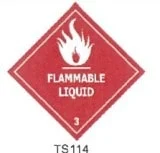
Class-4
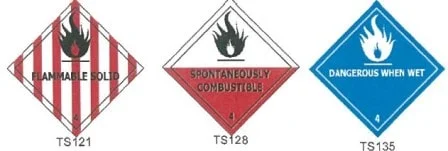
Class-5
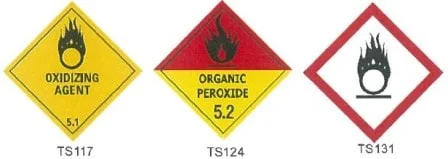
Class-6

Class-7

Class-8
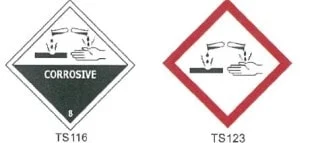
Class-9

Example of the Hazchem code:
| 1. Petrol | 3YE |
| 2. Methyl Alcohol | 2PE |
| 3. L.P.G. | 2WE |
| 4. Ammonia liquified | 2PE |
| 5. Sulphur | 2Z |
| 6. Kerosene | 3Y |
3YE:
- 3 – use foam to suppress the fire
- Y (with a V beside it in the table) – substance reacts violently (V); uses breathing apparatus and a fire kit to fight a fire, and contain a spill to prevent the spillage from entering a drain or watercourse.
- E – evacuation may be needed
4X:
- 4 – use a dry agent to suppress a fire.
- X – wear a liquid-tight chemical protective suit (LTS) with breathing apparatus to fight a fire; the substance does not react violently (no V); and contain a spill to prevent the spillage from entering a drain or watercourse.
2P:
- 2-use fog to suppress a fire.
- P-represent that it can be violently reactive hence Full body protection along with breathing apparatus is required. Spillage can be diluted and washed with water.
what is an emergency information panel?
The emergency information panel includes information of:
- Class diamond (That identifies what type of hazard is present).
- International UN number.
- The substance name (Propper shipping name).
- Specialist advice lines for emergency contact.
- Hazchem code.
In the emergency information panel, the top left of the section of the plate gives the emergency action code (EAC) telling what action to be taken in an accident. The middle left section contains a four-digit number that gives the UN substance identification number describing the material and in the lower-left section, the telephone number of the manufactures or suppliers is given. The warning symbol on the top right side indicates the general hazard class of the material and the bottom right of the plate carries a company logo or name.
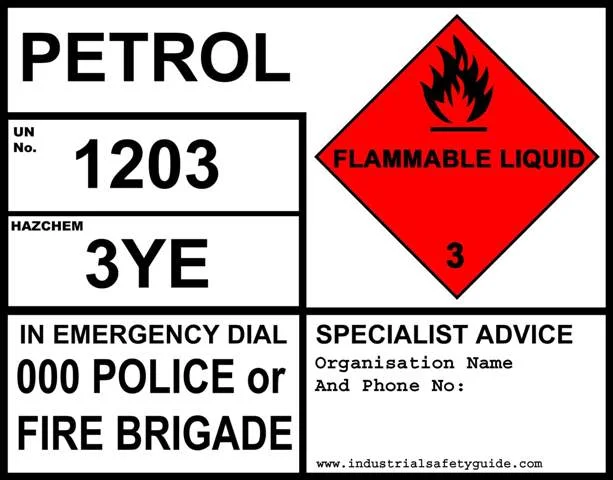
FAQ for the Hazchem code:
What is Hazchem code?
Hazchem code means hazardous chemical code. It is a warning plate system used for vehicles that transport hazardous substances. Actually, it gives information’s about the actions to be taken in case of accidental fire or spillage or leakage, or any emergency. The Hazchem code is a number, followed by one or two letters, e.g., 3WE, 2XE, etc
What is the Hazchem code for diesel?
Hazchem code for diesel is “3Z”.
What is a placard?
Placards are a way to alert emergency services and other people to the presence of hazardous chemicals and provide information about them.
What are the functions of a placard?
Function of placards
1.Alert people (workers, contractors, visitors, and emergency service personnel) to the presence of hazardous chemicals.
2.Identify hazardous chemicals stored in bulk (e.g., tanks).
3.Identify areas where significant quantities of hazardous chemicals in packages are stored.
4.Identify the hazards of goods present.
5.Indicate the required emergency actions for hazardous chemicals in tanks through the use of the HAZCHEM code.
